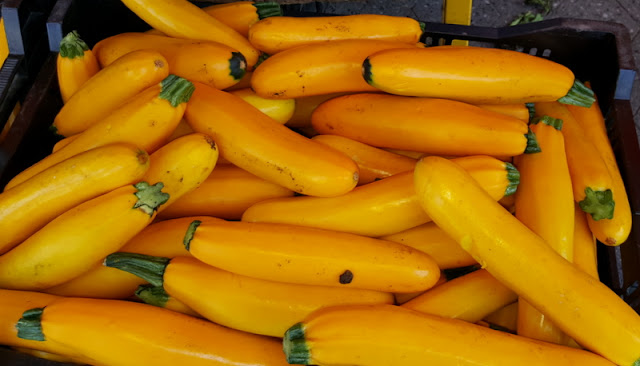These sunny produce photos come to us from my friend Bethanne, who needed some beach time and sun. She headed to Cartagena, on Columbia's Caribbean coast.
Cartagena comes highly recommended. Here's a description from Lonely Planet:
Catagena de Indias is the undisputed queen of the Caribbean coast, a fairy-tale city of romance, legends and superbly preserved beauty lying within an impressive 13 km of centuries-old colonial stone walls.What could be better? Oh yeah, some great produce! An Epicurious article, 12 Things to Eat in Cartagena, had this to say:
We're only slightly exaggerating when we say you can spend all your time in Cartagena sampling the mind-blowing selection of sweet, sour, acidic and just plain fascinating found-only-in-Columbia fruits. Try as much fruit as you can, whether it be a salad from one for the brightly dressed Palenqueras setting up shop in the shady Plaza de la Inquisicion; a street-vendor-sold fruit like uchiva or anon, with its pineconey exterior and sweet and custardy interior; or a morning juice of nispero or maracuya (passion fruit).
What are these fruits? My Brazilian friends introduced me to South American sweet-tart and best-for-juices sour fruits, and Columbia seems to have plenty of them too. Thanks to two helpful guides, Columbian Fruit: My Mission to Try Them All and Fruits in Colombia, I learned more about the Columbia's produce offerings. Uchiva, for example, is also known as the Cape Gooseberry and looks like a cherry tomato covered by a husk. Yes, very similar to the husk cherries I've bought at farmers' markets in New York! Anon is another member of the lizardy and delicious armored band of fruits that include the cherimoya and guanabana. Maracuya is one of a zillion kinds of passion fruit found in Columbia. Some other kinds are granadilla, gulupa and curuba.
Bethanne thoughtfully included a picture of some passion fruit from the fruit vendor. Passion fruit have many seeds encased in goopy capsules, hence the appeal of using them for juices or jams.
(My South American friends have tended to be huge passion fruit enthusiasts, but I haven't really enjoyed the passion fruit I've bought at NYC fruit stands. Fair enough: I am withholding judgment until I get closer to the source. I sure wouldn't want someone to form an opinion before trying a NYC bagel.)
Another fruit mentioned in the Epicurious article, and included prominently in the second photo and photo below: nispero. Nispero, and the similar but larger fruit, zapote, look a bit potato-like, with a peel the color of a dirty paper bag. Zapotes are tropical fruits I first encountered in Asia, and nisperos looks like kid siblings, sized more like kiwis than spuds. Zapotes taste like sweet potatoes, albeit with an astringent kick. I assume nisperos are in the same family of taste. I wouldn't have thought to juice them, but it looks like the juicers are always running in Columbia, so every fruit has juice potential. (I am not knocking this innovation, similar to the thinking that gave the world deep fried Mars bars.)
Not everything for sale is that exotic, of course. Bananas, papayas, avocado and tamarind are prominently offered.
So are grapes, oranges, apples and pears.
Avocados!
Tomatoes, carrots, peppers, pineapples, cucumbers and limes.

I think those rosy fruits in front next to the zapotes are mangoes. I'm hoping the blackish purple fruit next to them are something exotic, but they might be plums. And where are the shoppers?
At least one shopper has found something. Well, produce isn't the only agricultural product available.
And after all, no one can live on jugo de maracuya alone.

























































